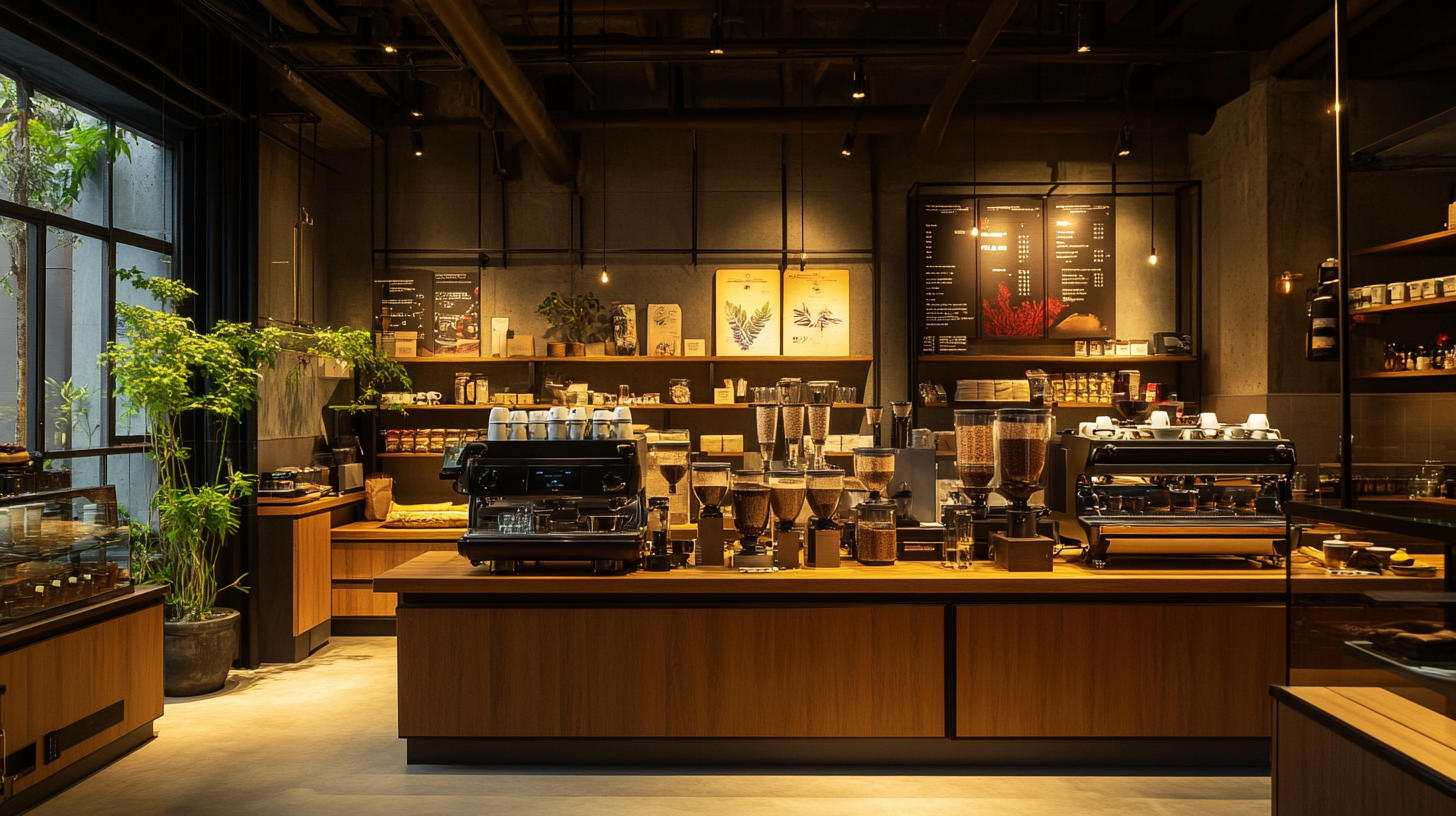

Navigating Global Trends in Barista Coffee for 2025 and How to Source the Best Beans
As we approach 2025, the landscape of Barista Coffee is poised for significant transformation, driven by evolving consumer preferences and global market trends. According to the Specialty Coffee Association, the global coffee market is projected to reach USD 155.64 billion by 2026, reflecting a CAGR of 5.5% from 2021. This growth is fueled by the increasing demand for high-quality, specialty coffees, which has elevated the role of baristas as both artisans and advisors in the pursuit of the perfect cup.
In this dynamic environment, sourcing the best beans has become more crucial than ever. Research from the International Coffee Organization highlights that the specialty coffee segment now accounts for over 50% of the coffee market by value, underscoring the importance of quality sourcing practices. Baristas are now focusing not only on the brew methods but also on traceability and sustainability of the beans, which aligns with consumers' growing consciousness around responsible sourcing. This blog will delve into the critical trends shaping the Barista Coffee industry and provide insights on how to source the finest beans in this evolving market.

Exploring Emerging Coffee Trends Shaping the Barista Industry in 2025
As we look toward 2025, the landscape of the barista industry is undergoing significant transformation, influenced by a variety of emerging coffee trends. According to the International Coffee Organization, global coffee consumption is projected to reach 178 million 60-kilogram bags by 2025, highlighting a growing demand for high-quality, sustainably sourced beans. The barista industry is embracing this shift, prioritizing transparency in sourcing, and favoring single-origin beans that not only deliver unique flavor profiles but also support ethical farming practices. Sustainability is at the forefront of coffee trends for 2025, with a 2023 report from the Specialty Coffee Association indicating that 65% of consumers now prefer brands that are environmentally responsible. This has prompted baristas to seek out suppliers who prioritize sustainable practices, including regenerative agriculture and fair trade certification. As a result, coffee shops are increasingly focusing on educating their customers about the origins of their beans and the importance of sustainable sourcing. In addition to sustainability, the rise of innovative brewing methods and coffee experimentation is shaping the barista scene. With a 2022 survey revealing that 72% of coffee enthusiasts are eager to try new flavors and brewing techniques, baristas are experimenting with alternative brewing devices such as the Aeropress and siphon. This trend not only enhances the customer experience but also allows baristas to showcase their skills and creativity in crafting unique beverages that reflect the diverse profiles of specialty coffee. As we move towards 2025, baristas who adapt to these emerging trends will undoubtedly have the upper hand in a competitive market.

Identifying the Best Coffee Bean Varietals for Unique Flavor Profiles
In the ever-evolving world of coffee, the varietal of beans plays a critical role in crafting unique flavor profiles that cater to emerging consumer preferences. As we look toward 2025, baristas and coffee enthusiasts alike should consider focusing on lesser-known coffee varietals that offer distinct tastes and aromas. For instance, the Geisha varietal, renowned for its floral notes and tea-like qualities, has garnered significant attention in specialty coffee circles. Understanding the attributes of such unique beans is essential for creating innovative coffee experiences that stand out.
Another varietal gaining popularity is the Pacamara, characterized by its large size and rich, fruity flavors. This hybrid bean, a cross between Pacas and Maragogipe, brings a complexity that can elevate any brew. Baristas should educate themselves on the cultivation and processing methods of these beans, as they significantly influence the final flavor. Sourcing beans directly from farmers who prioritize sustainable practices and high-quality processing can also enhance the unique profiles of these varietals.
Additionally, the trend of direct trade is becoming increasingly important for sourcing exceptional coffee beans. Engaging in direct relationships with coffee producers not only ensures quality but also allows baristas to explore unique flavor profiles tied to specific regions. By investing time in understanding the origin and processing techniques of different varietals, baristas can offer customers a more personalized coffee experience marked by depth and character. Embracing these unique bean offerings in 2025 will not only differentiate a café's menu but also resonate with consumers seeking authenticity and extraordinary flavors in their daily brew.

Sustainable Sourcing Practices: Ethical Considerations for Coffee Beans
As the global coffee market continues to evolve, ethical considerations in sourcing become increasingly critical for both brands and consumers. Recent reports indicate that the green coffee market is projected to reach approximately USD 59.7 billion by 2033, growing from USD 37.7 billion in 2023 at a CAGR of 4.3%. This substantial growth underscores the escalating demand for coffee, driving specialty coffee shops to anticipate an increase in market size by USD 50.8 billion between 2025 and 2029, largely fueled by rising coffee consumption.
However, the industry faces significant challenges regarding ethical sourcing practices. Starbucks currently finds itself embroiled in legal issues, accused of misleading customers about the ethical sourcing of its coffee. The lawsuit alleges that the company has benefited from child and forced labor while promoting its commitment to 100% responsibly sourced coffee by 2025. This situation highlights a broader conversation within the industry about the authenticity of claims made by major coffee brands and the pressing need for transparency in the supply chain.
Consumers are now more informed and concerned about the origins of their coffee. They are encouraged to seek out brands that prioritize sustainability and ethical practices. For instance, companies like Dunkin’ are actively promoting their efforts through initiatives like the Drive-To Sustainability Program, aiming for a fully ethically sourced coffee supply by 2025. As consumers increasingly align their purchasing decisions with their values, the importance of ethical sourcing in the coffee industry becomes clear, shaping the landscape for future growth and innovation.

The Role of Technology in Enhancing Barista Craftsmanship and Efficiency
In the rapidly evolving coffee industry, technology plays a pivotal role in enhancing barista craftsmanship and operational efficiency. According to a recent report by the International Coffee Organization, the global coffee market is projected to grow at a rate of 4.2% annually through 2025. This surging demand necessitates innovative solutions to maintain quality while boosting productivity. Advanced espresso machines, such as those developed by leading companies like CAYE, offer features like precision brewing and automated cleaning systems, allowing baristas to focus on their artistry without compromising on speed or flavor.
Data from a recent industry survey indicated that 68% of coffee shop owners recognize the importance of upgrading equipment to meet consumer expectations for quality and efficiency. CAYE's latest offering emphasizes these elements, showcasing how machine learning integration can help baristas enhance their skillset and productivity. By leveraging technology, these machines provide data analytics that help optimize brewing parameters based on customer preferences, thus ensuring consistency in every cup served.
Additionally, the role of mobile applications in streamlining operations cannot be overlooked. Many coffee brands are adopting these digital tools for order management and inventory tracking, which not only speeds up service but also reduces waste. As baristas embrace these technological advancements, they are better equipped to navigate the complexities of sourcing the best beans, resulting in an elevated coffee experience for consumers. With these trends paving the way for 2025, the intersection of technology and barista craftsmanship is set to redefine how we appreciate coffee.
Crafting a Unique Coffee Menu: Experimenting with Global Influences and Local Tastes
As coffee culture continues to evolve globally, a well-crafted coffee menu should reflect an exciting blend of international influences while honoring local tastes. Experimenting with global flavor profiles allows baristas to introduce unique offerings that captivate a diverse clientele. By incorporating elements from various coffee traditions, such as the Ethiopian coffee ceremony or Brazilian cold brew methods, baristas can create a rich tapestry of flavors that tell a story.
One effective approach is to identify local preferences and pair them with global trends. For instance, if your community favors sweeter beverages, consider incorporating ingredients like spiced caramel reminiscent of Middle Eastern coffee styles or adapting traditional Thai iced coffee recipes with the local milk of choice. It’s all about innovating within the familiar, allowing customers to explore coffee that resonates with their tastes while satisfying their curiosity for global flavors.
Additionally, consider seasonal ingredients that reflect local agricultural practices. Collaborating with nearby farmers could inspire unique offerings like coffee blends featuring local fruits or herbs, marrying global brewing techniques with the essence of your region. This strategy not only supports local economies but also fosters a sense of community around the coffee experience. Ultimately, creating a unique coffee menu by balancing global influences with local tastes can profoundly enhance both customer engagement and brand identity in the competitive coffee landscape.
